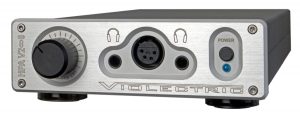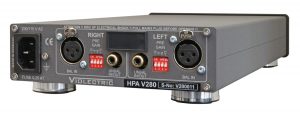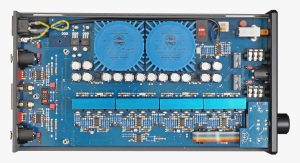The venerable Violectric V200 headphone amplifier has been a mainstay of many headphone enthusiasts looking to get the most out of their headphones over the past number of years. It certainly was on my “recommendation list” for newer members looking to move up the amplifier food chain. I found the V200 a very dynamic sounding unit with plenty of power to drive most headphones. As well, some amplifiers in this range sounded on the brighter side of things, the V200 offered a relaxing presentation that was almost tube-like. I would describe that amplifier as dynamic, transparent and still very natural sounding. Well, never to rest on their laurels, the folks at Violectric are back with the newly released V280 headphone amplifier. Very much in the same design motif, the V280 offers a very clean and streamlined appearance and with its small package can fit into almost any setup with very little effort. But don’t let the small design factor fool you; this amplifier can power pretty much any headphone out there not named the Hifiman HE-6 (now discontinued). The V280 can output up to a whopping 5.3 W into a 100 ohm pair of headphones! That’s plenty of juice for pretty much every non-electrostatic headphone out there today. The V280 also offers the ability to stand as an “all-in-one” solution for your personal audio desktop needs as it can be upgraded to include a digital-to-analog converter (DAC).

As mentioned, the design appearance of the V280 is reminiscent of its very popular predecessor the V200. The all black face plate and grey body certainly offer a strong familial resemblance. I was always a fan of this type of streamlined appearance; not flashy but solid are the words that first come to mind when I opened up the box. The sample provided for this review was for the amplifier only (without an included DAC). The source that I used for this amplifier was my Chord Hugo TT. I did try both balanced and un-balanced inputs into the V280, but after some initial trials with balanced headphones I had on hand (Sennheiser HD800S, Hifiman HE-1000 V2 and Audeze LCD-4), I quickly determined that running this amplifier fully balanced offered better control of the drivers and yielded a more transparent sound. Setup was very easy, I just plugged in my Hugo TT DAC with balanced XLR cables into the V280, hooked up the power and my headphones and I was off to the races! Here is a full specification listing for this amplifier:
Features:– Balanced inputs with gold-plated Neutrik XLR connectors
- Unbalanced inputs with gold-plated ALPS RCA connectors
- switchable unbalanced outputs with RCA connectors
- optional digital input (USB or Coax or Optical)96 or 192 kHz
- PRE-GAIN = switchable input gain in five steps
- Independent-channel design
- ALPS RK27 High-Grade volume control
- High-Quality op-amps in the signal path
- High-quality MKP capacitors in the signal path
- 0.1 and 1% metal film resistors throughout the unit
– 4 amplifiers with V200 technology – 1 balanced headphone output, Neutrik 4-pin, gold plated - 2 single ended silver-plated Neutrik headphone outputs
- Relay-based headphone output cutoff
- 2 large toroidal transformers
- Large filtering capacitors in the power supply
- Switchable ground lift
- Rugged aluminium case with Nextel coating
- Solid, laser-engraved aluminium front panel
Specifications:
| Balanced Inputs: | 2 x gold plated XLR connectors |
| Unbalanced Inputs: | 2 x gold plated RCA connectors |
| Impedance: | 10 kOhms |
| Unbalanced Line Outputs: | 2, gold plated RCA connectors |
| Amplifier Channels: | 4 (Stereo Push-Pull) |
| Nom. input level: | + 6 dBu |
| Amplifier Gain: | +8 dB |
| … with PRE-GAIN: | -4 / +2 / +8 / +14 / +20 dB |
| Frequency range: | 0 Hz … 60 kHz (-0.5 dB) |
| Output Impedance: | 0.165 Ohms |
| Damping Factor @5 0 Ohm: | 300 |
| Dynamic range: | > 129 dB (A-wtd) |
| Noise: | < -97 dBu (A-wtd) |
| THD+N: | < -102 dB @ 10V in 100 Ohms (1W) < -99 dB @ 4V in 32 Ohms (0.5W) |
| Crosstalk: | < -115 / -105 dB (@ 1 / 15 kHz) |
| Max. output level (bal. mode): | > 32.9 Veff in 600 ohms = 1800 mW |
| > 28.2 Veff in 300 ohms = 2650 mW | |
| > 23.0 Veff in 100 ohms = 5300 mW | |
| > 12.4 Veff in 50 ohms = 3100 mW | |
| > 9.1 Veff in 32 ohms = 2600 mW | |
| > 4.9 Veff in 16 ohms = 1500 mW | |
| unbalanced Outputs: | 2 x 1/4″ phone jacks |
| balanced output | 1, gold plated 4-pin XLR connector |
| Power supply: | 230 / 115 V AC 30 VA |
| Dimensions: | 170 x 49 x 320 mm (W x H x D) |
| Case Material: | Aluminum |
Based on these specifications, you really have all of your bases covered; from in-ear monitors to full sized power hungry orthodynamic headphones like the Audeze flagship the LCD-4. One thing not mentioned here is the extremely low background noise level. This amplifier is dead black when no music was played, this feature is ideal for really sensitive IEMs or headphones where no background “hiss” or noise could be detected. Very impressive indeed!

As mentioned earlier, my main source for this review was my Chord Electronics Hugo TT in balanced mode to feed the V280 and my music varied from CDs, to Tidal Lossless to high resolution 192kps and DSD recordings. I literally threw all the best I had on hand at this amplifier to put it through its paces. My headphones used where:
Balanced operation: Sennheiser HD800S, Audeze LCD-4, and Hifiman HE-1000 V2
Unbalanced operation: Grado PS1000e, Focal Utopia
Hookup was quite simple. I used this amplifier primarily with balanced inputs from my DAC (Chord Hugo TT), but I did find the XLR inputs a bit tight with my Audioquest Water balanced cables. I’ve used these cables on several different amplifiers and never had any issues. Upon first listen with the newly released (and very impressive) Hifiman HE-1000 Version 2 headphones (in fully balanced mode) revealed a very natural sounding amplifier and from memory, a good step up in transparency over its V200 predecessor. My 192kps high resolution version of Macy Gray’s “Stripped” was a pure audio joy with this setup. Macy’s vocals were beautifully portrayed and her sultry voice was just magical. This is one brilliant album that I’ve come to really appreciate since its release and it will definitely be added to my listing of material to review new gear with. The V280 has an amazing ability to portray female vocals and when compared to other amplifiers in this price range (like the Burson Soloist), the fullness and naturalness of the V280 really came to the forefront for me. The bass notes on this recording were very satisfying. I never found myself wishing for more rumble from down low. When compared to my HeadAmp GS-X Mk2, there was a bit more bloom and fullness to the bass notes on the V280. This offered a more musical impression, but when carefully considered, it did seem to slow things down a touch and take a bit away from the overall transparency. But keep in mind the GS-X Mk2 comes in at 2X the price of the V280. I want to clarify that this was quite small and for those who love a more “tube” like bloom and warmth will love the V280! The other thing I want to mention is that this amplifier kicks like a mule. It has plenty of power on tap to drive any power hungry headphone you can throw at it and never run out of steam. I re-listened to this recording with the “difficult to drive” Audeze LCD-4 orthodynamic headphones. Coming in at 200 ohms impedance and 97dB/mW, I’ve found over the past several months that they truly hit their full stride with an amplifier that can power them sufficiently. Well, the V280 does just that and without breaking a sweat!
Frank Sinatra’s “Sinatra at the Sands” is one of the greatest live albums of all time and the recording quality is just excellent. Considering that it was recorded in 1966, the sound quality competes with reference quality recordings released today. Having the Count Basie Orchestra as a back up to Old Blue Eyes was so much more than just an added bonus. When taken as a whole, this album reveals what it must have been like to be sitting in the Sands Hotel & Casino with Frank and The Count right in front of you. For this recording, I selected my Focal flagship headphones, the Utopia. What I heard was as if I was in a sonic utopia! I was transported in both time and place with this setup and found myself back in 1966 in Las Vegas. The smallest of details of the audience were all readily apparent as portrayed through the Utopia headphones and V280. I’ve found that the Utopias are a ruthlessly revealing pair of headphones and if an amplifier or source are not up to the task; they will definitely let you know. And I am happy to confirm that Violectric’s newest entry was certainly up to this task. Being quite efficient and sensitive headphones, the Focals can pick up background noise if your system isn’t dead silent. But with the V280, the background was simply black. I used a lower gain setting with these headphones and if not for the LEDs on the front panel, I would have thought that the amplifier wasn’t plugged in as all I heard was dead silence. On the issue of gain settings, while the V280 gives you a wide range of settings to power pretty much everything from sensitive headphones or IEMs and all the way up to the most power hungry orthos, the V280 can pretty much power anything. But the DIP switches on the back of the amplifier made switching between these settings a bit cumbersome and I would have preferred this option somewhere on the front face plate for easier access.

The sound staging ability of the V280 was brilliant with the Focal flagship headphones. The V280 has a wonderful rich tone that envelops the listener while never sounding slow. Frank’s voice comes back alive and The Count Basie Orchestra has truly never sounded better. As previously noted; the V280 offers a bit of a tube like essence into the music and offers a very natural sound. I could listen to this amplifier for hours and never find myself fatigued. While some of the shimmer details may be pushed back on the cymbals, the overall presentation is very musical and very “real” sounding. I was thoroughly impressed with the V280’s ability to portray an accurate mental picture and still remain a pleasure to listen to.
Coming in at $1649.95USD (without an included DAC), the V280 is a brilliant option for anyone looking for some tube magic on a solid state setup and an amplifier than can pretty much power anything you can throw at it. The transparency and clarity was quite impressive and when coupled with the more natural and tube-like presentation, this amplifier really pulled ahead of the competition for me and it will definitely become my “go to” recommendation for anyone in the $1500 or so price range. Colour me impressed!















Reply
Reply
Reply
Reply
Reply
Want to join discussion?
Feel free to contribute!